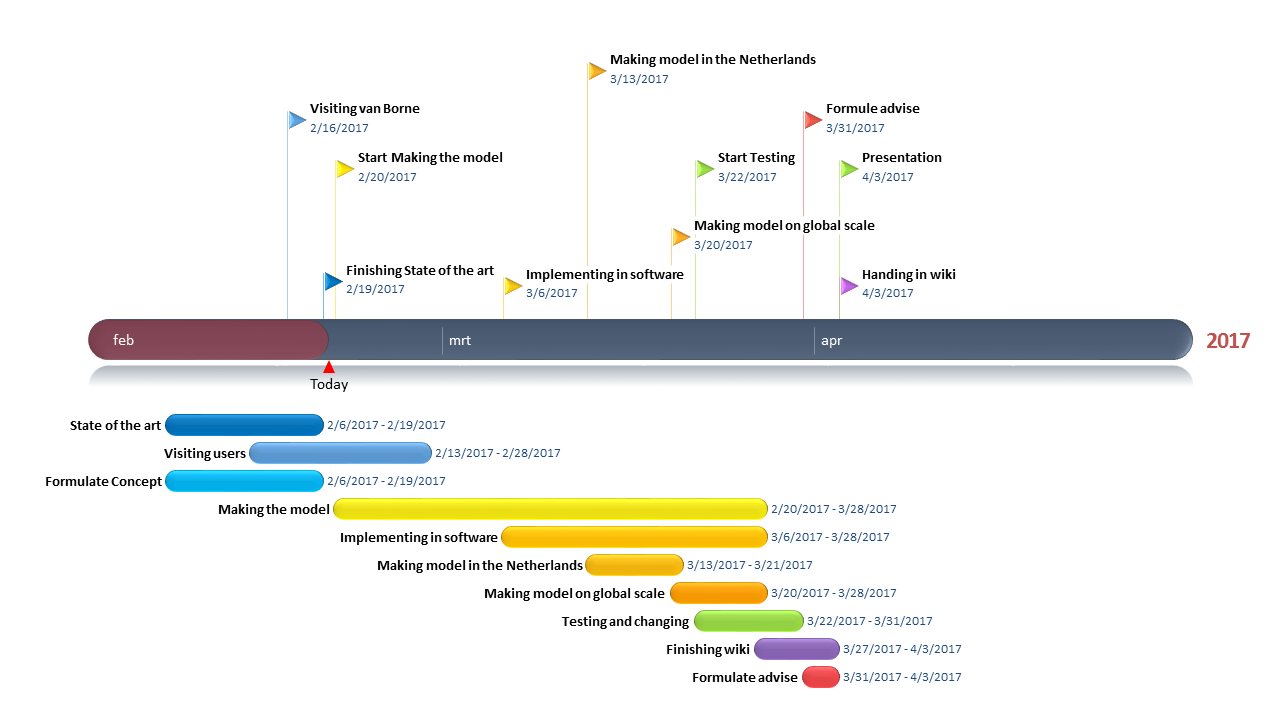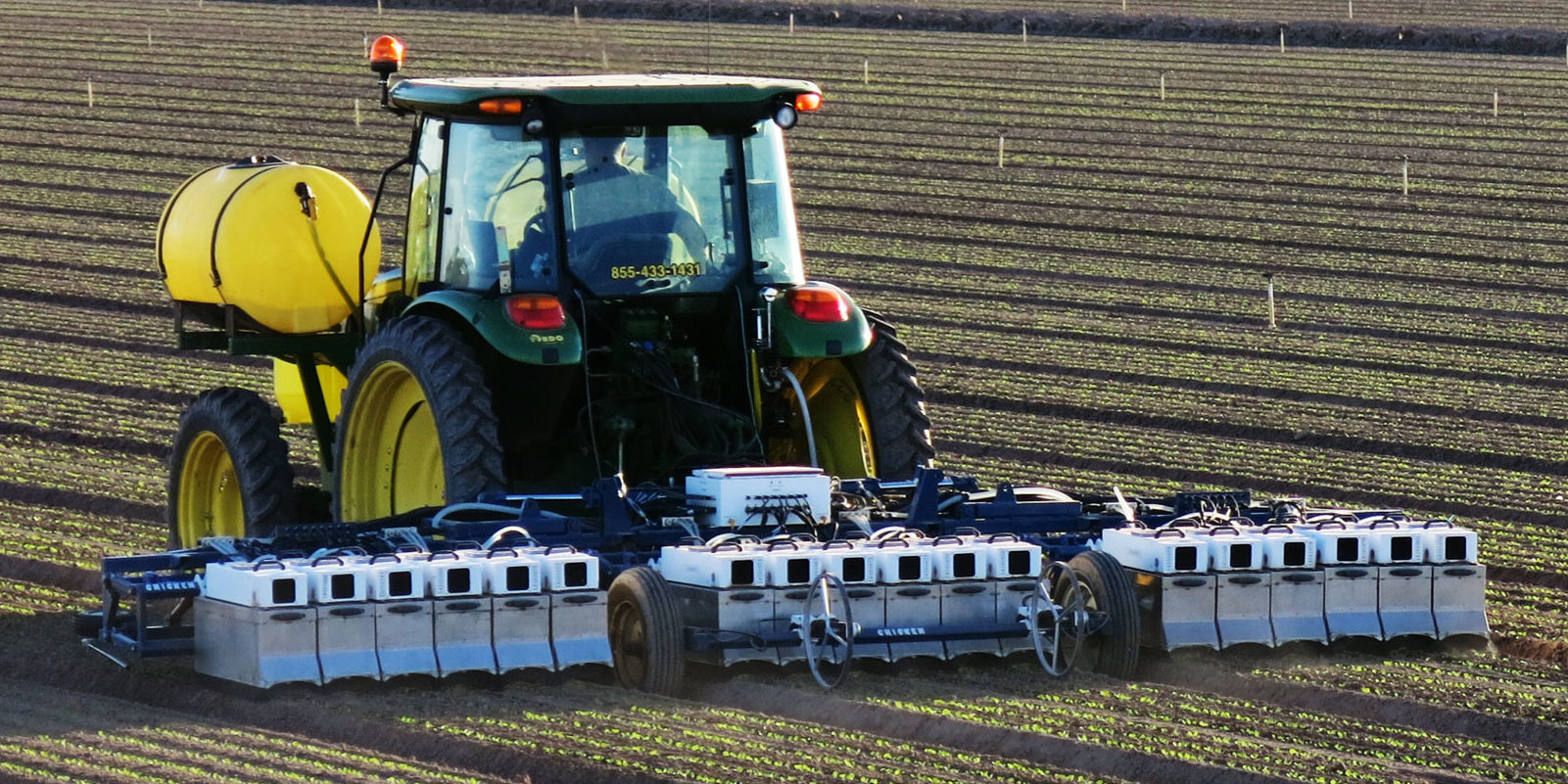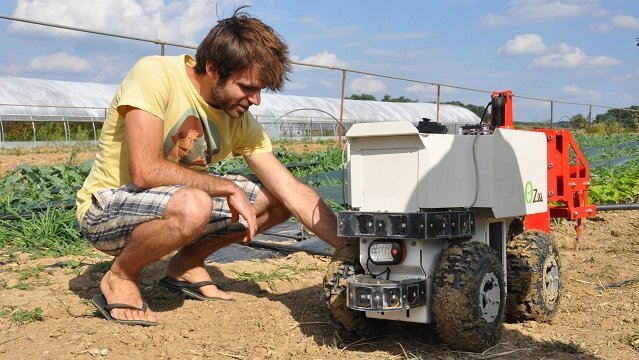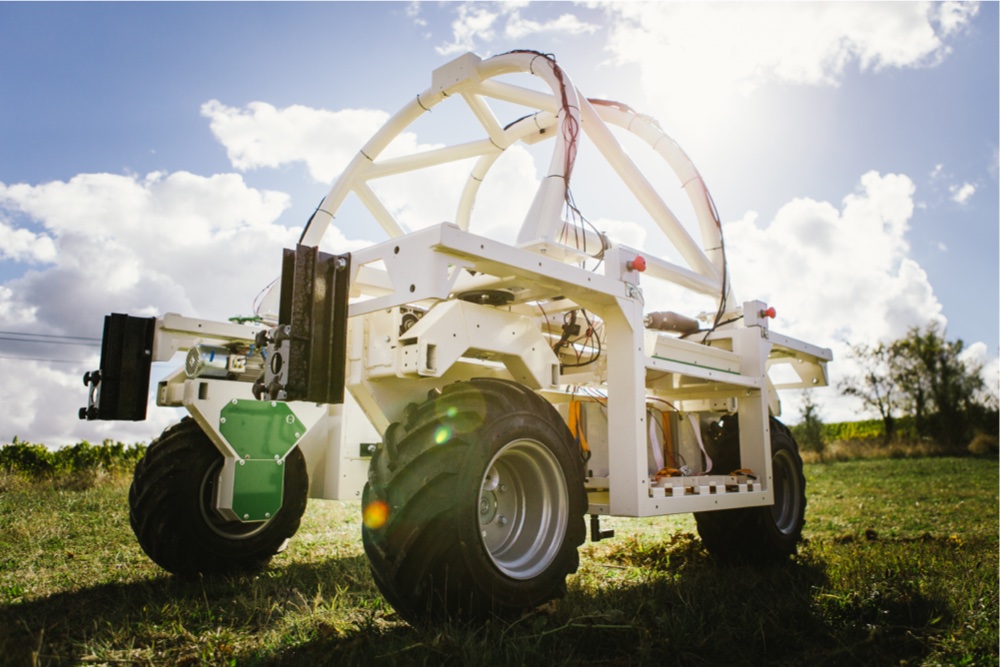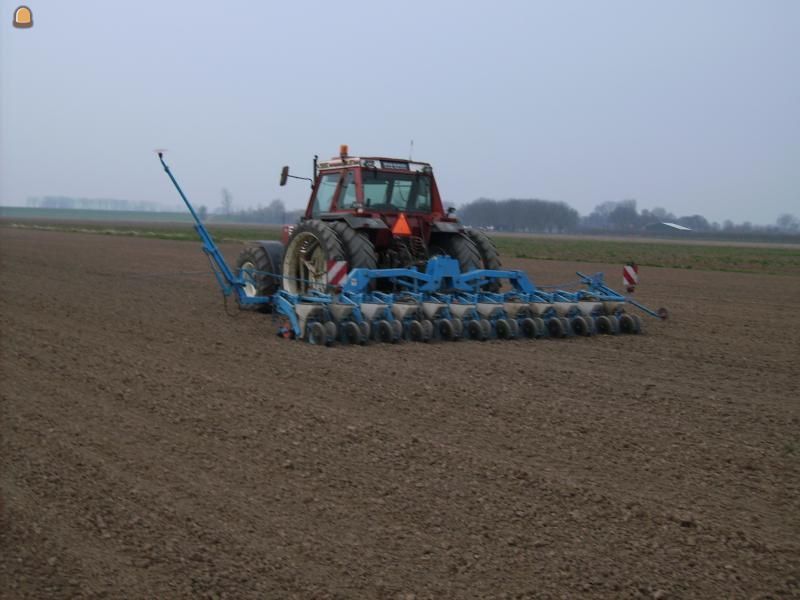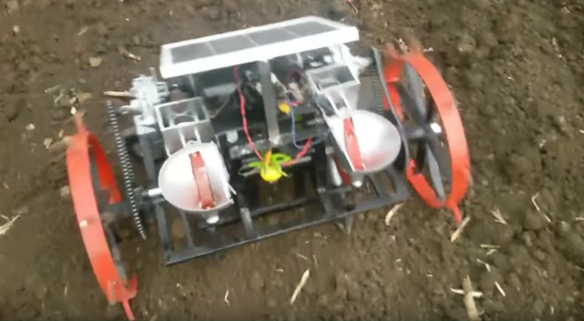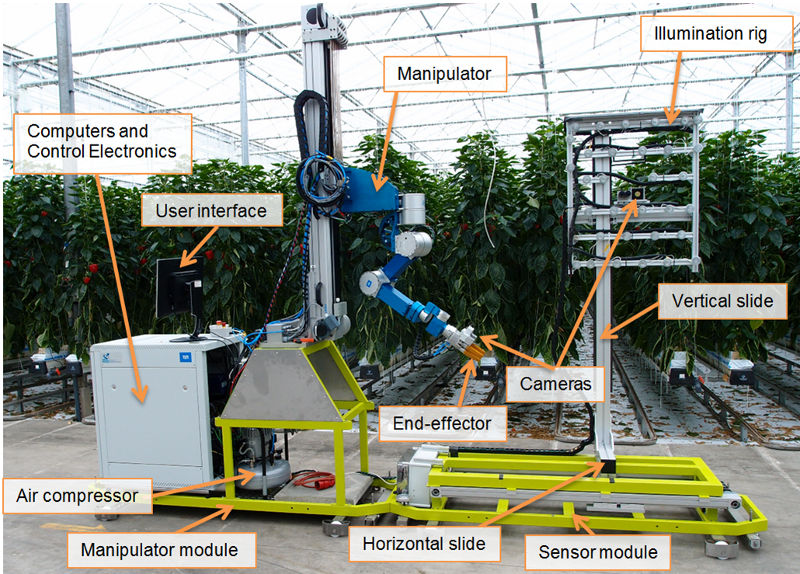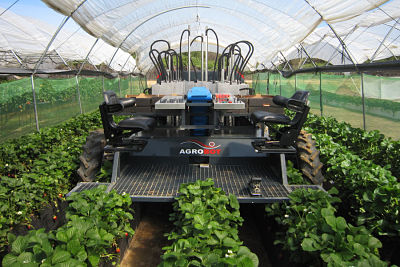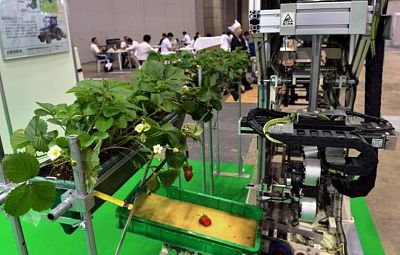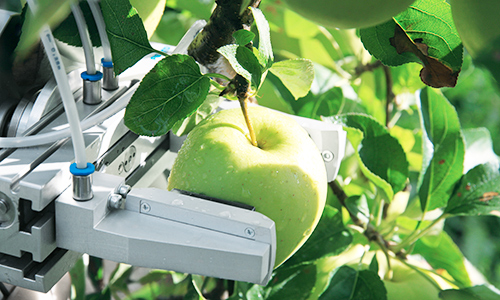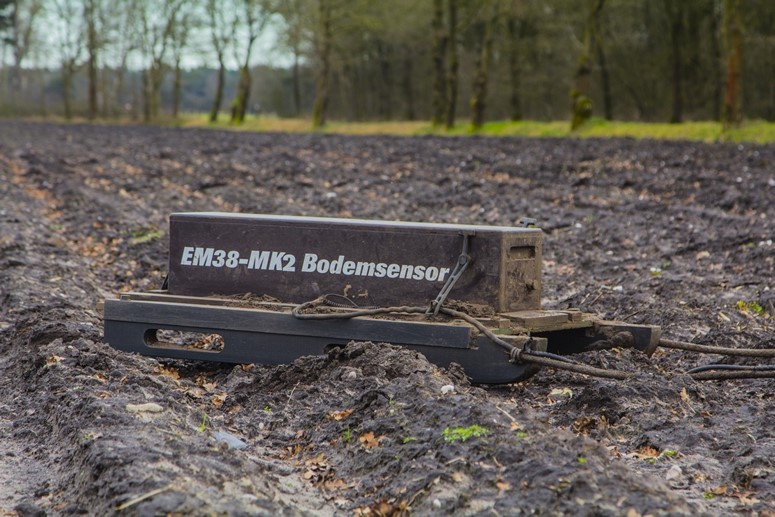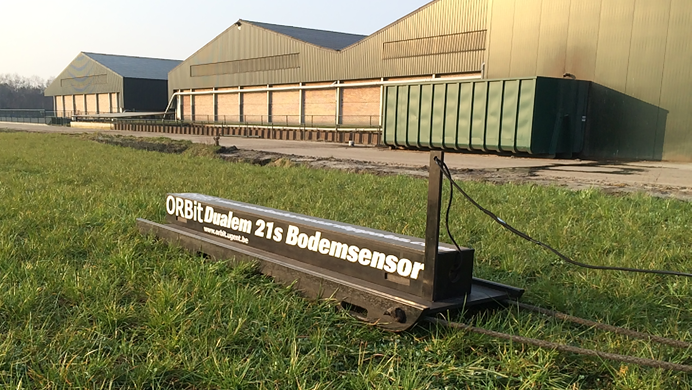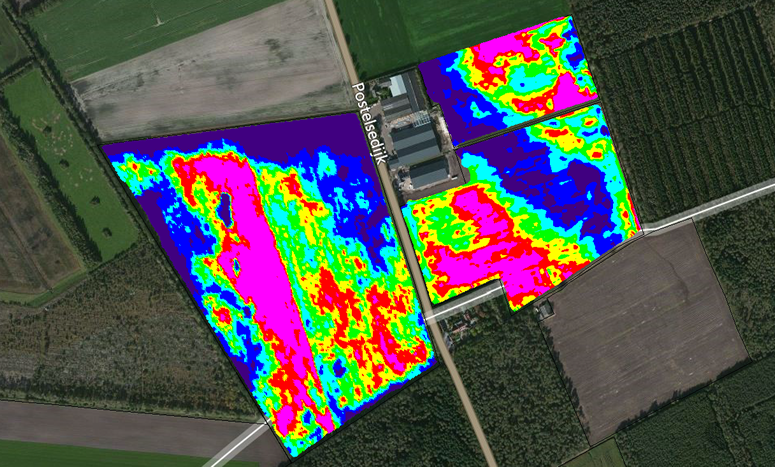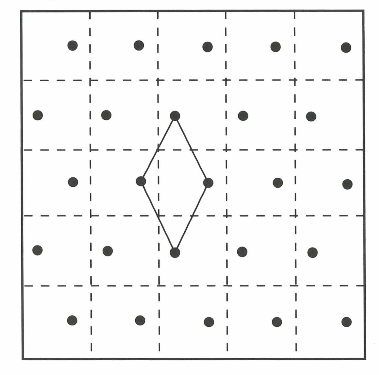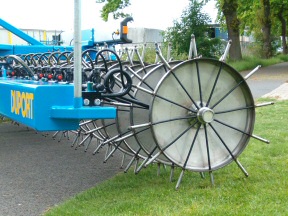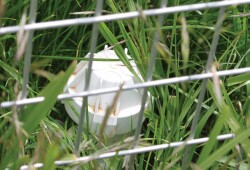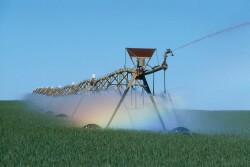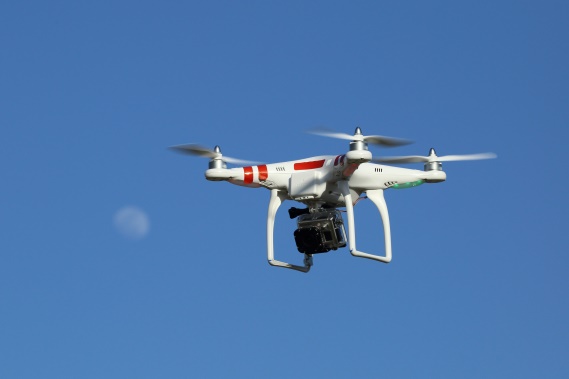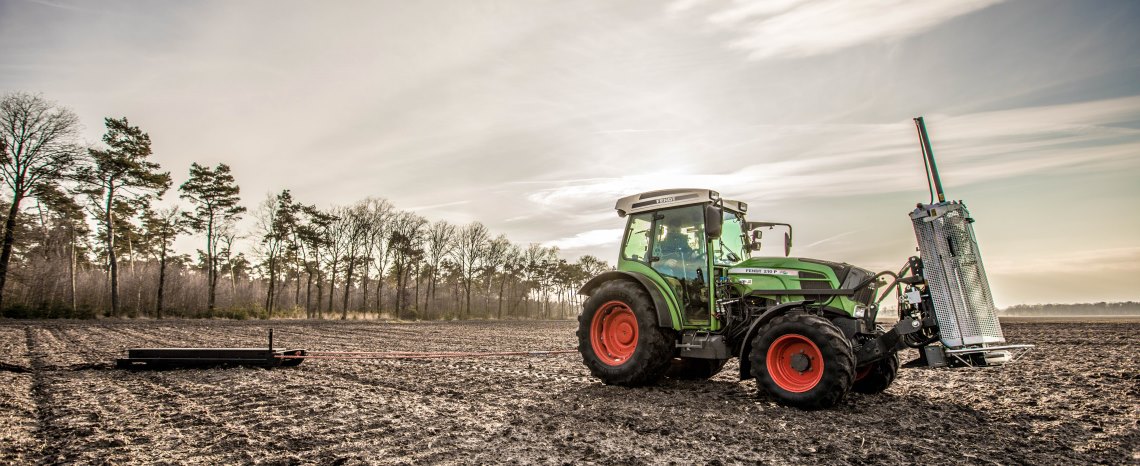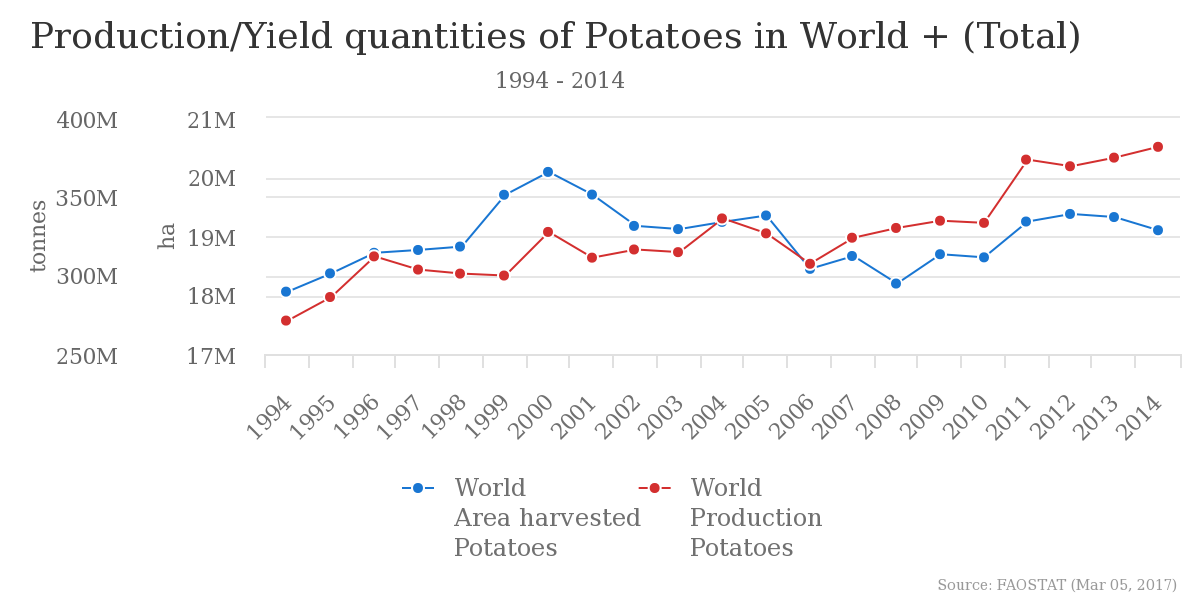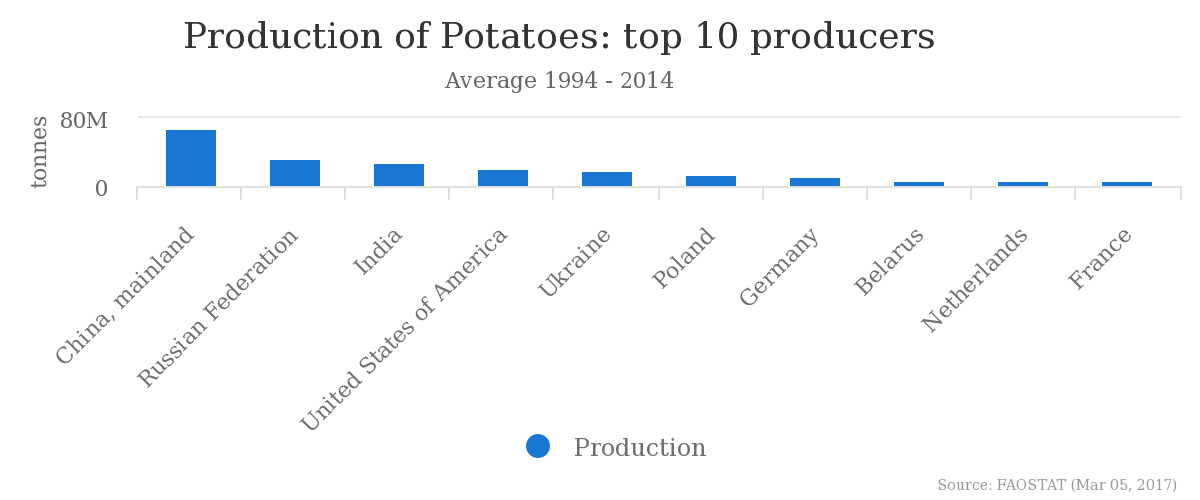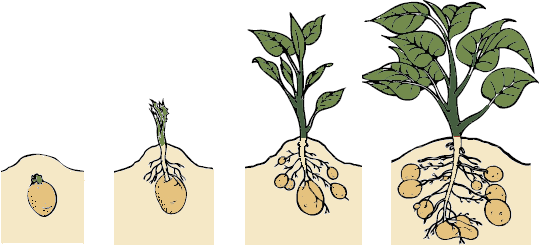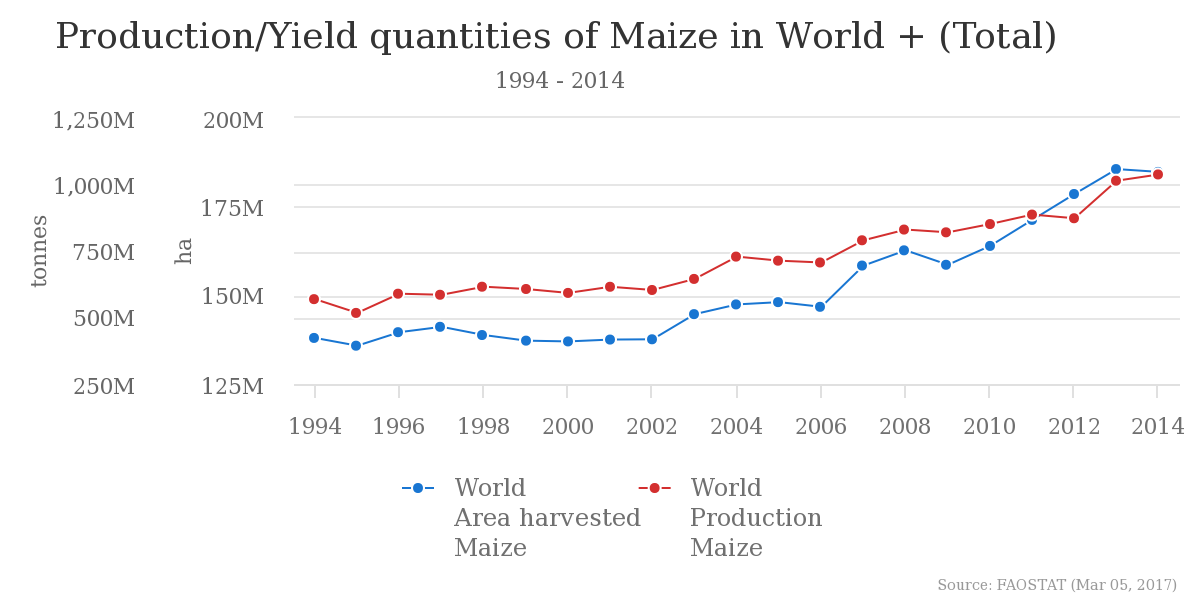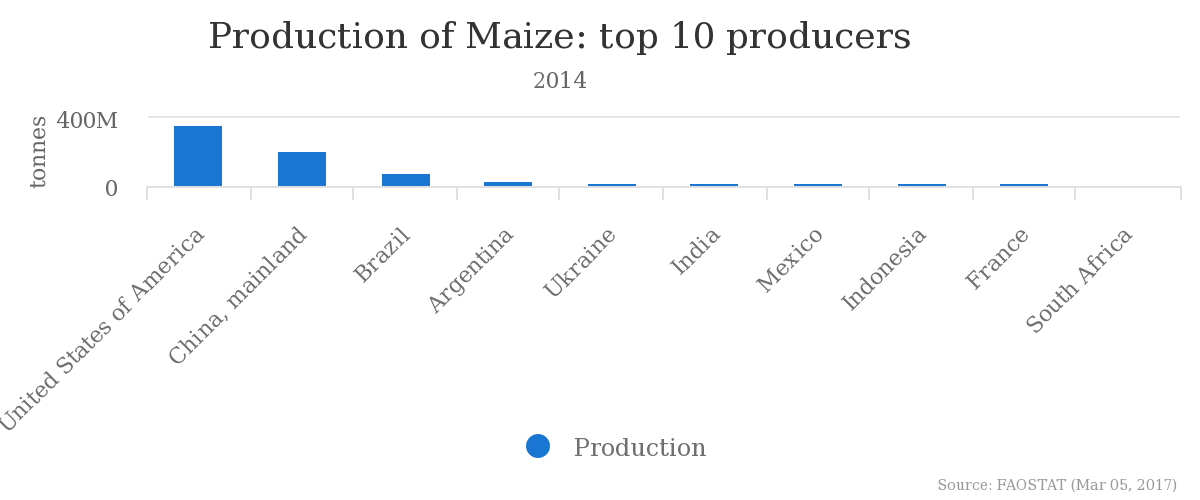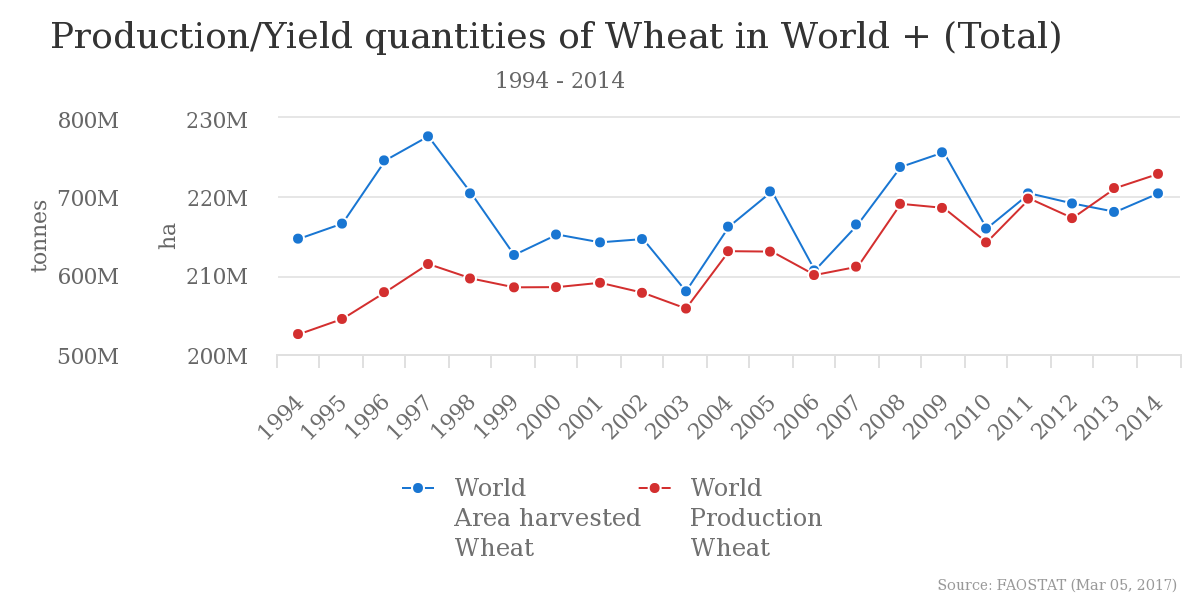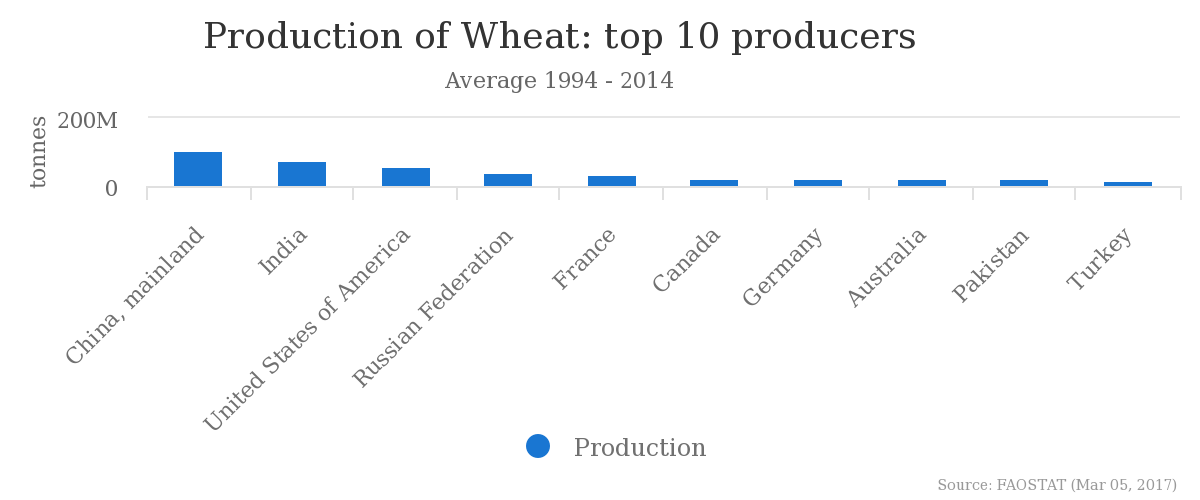PRE2016 3 Groep1: Difference between revisions
| Line 556: | Line 556: | ||
[[File:Stages.gif| 400px]]<ref name=fao_potato_cultivation/> | [[File:Stages.gif| 400px]]<ref name=fao_potato_cultivation/> | ||
---- | |||
==='''Maize'''=== | ==='''Maize'''=== | ||
===='''Production'''==== | ===='''Production'''==== | ||
Revision as of 09:42, 6 March 2017
Group members
- Guus van Dongen 0960106
- Johan Somers 0876720
- Teun de Groot 0951139
- Jur Bartels 0885497
- Laurence Keijzer 0900387
- Bastiaan Wuisman 0884362
Project Description
The world population is growing very fast [1]. It is expected that the world population reaches 11.2 billion people by the year 2100. Nowadays around 800 million people will go to bed without a proper meal [2]. This problem will only grow when the world population increases. To tackle this problem, precision argiculuture and robotics can be a solution. Precision agriculture is way to reduce the the amount of fertliser, water, seeds and fuel used and increase the overal efficiency and gainings of the fields.
Besides the global impact which precision agriculture and robotics can have on the ecology and the food production, it may of course also be a very interesting investment for company to decrease the costs and increase the production on the same field.
So the what will the deliverables of this project be?
A user-friendly interface will be presented in which the economical and ecological impact of robotics in agriculture and precision agriculture is showed. This model will apply on a company scale and on a global scale. The interface will be made with Java. The initial focus will be on the impact of the use of drones in agriculture. More specific: the impact which image processing of the pictures drones take of fields can have. All the parameters which can be obtained from these pictures will be elaborated later, but some examples are the nutrition of plants and the growth of crops.
To create the user-friendly interface, a mathematical model will be implemented. As can be seen in the planning underneath first a model which is suitable for The Netherlands will be made. This model will have inputs (parameters the farmer or other user have to submit), proces constants (constants which are inside the model, submitted by the programmers), proces variables (variables used to get to the final output) and outputs (information which is the result of the model and are showed to the user). A table of these variables can be seen in the 'Models' section.
The inputs of the model can be submitted with different means, for example sliders, dropdown menu's and input fields.
Use Aspects
It is important to check what the USE aspects are when we want to locate the problem and try to invent something for it. The use of drones can have inpact in the following USE related toppics:
USE aspects
- Societal problem of hunger
- Cheaper food for user
- Cheaper then workers in the long run
The following USE-agents are chosen for this project:
- Primary Users: The primary users for the drones are the farmers. They are going to work with the technology as a tool to optimise the food production.
- Society: This accounts for everyone, since everyone needs food.
- Enterprise: The companies who produce the drones and software.
Project Planning
Week Planning
The general approach to create a succesfull project is:
- Research state of the art
- Abstract from state of the art
- Contact with user
- Create model
- Analyze impact
Week 1
- Create presentation
- Determine concept idea of drones helping for agriculture
- Research about state of the art
Week 2
- Finish the state of the art [milestone]
- Weeding
- Seeding
- Fertilize
- Harvesting
- Irrigation
- Crop protection
- Contact with User
- Definition of the problem
- Visiting van den Borne [milestone]
- Create presentation
- Create planning
- Evaluate scenario
Week 3
- Contact with User
- Contact with 'Jan Staal adviesbureau' made (Has contact with many farmers)
- Contact with 'Johannes Strever' (Uses GPS a lot)
- Contact with University Team (Are developing a drone for van den Borne)
- Formulate concept [Milestone]
- Start of the model [Milestone]
- Search for essential information (data)
- Economical
- Ecological
- Company scale
- Global scale
- Software: what software are we going to use
- Update wiki
Week 4
- Implementing the model in software [Milestone]
- Update wiki
Week 5
- Finished model of application in the Netherlands [Milestone]
- Update wiki
Week 6
- Finished model global scale [Milestone]
- Update wiki
Week 7
- Testing the models [Milestone]
- Changing the models
- Update wiki
Week 8
- Finished Wiki [Milestone]
- Formulated advise [Milestone]
- Prepare Presentation
- Giving Presentation
Gantt chart
Responsibilities
Tasks
| Task divison week 3 | |
|---|---|
| Crops research | Bastiaan + Laurence |
| Edit wiki | Jur |
| Contacting users | Guus |
| Consultancies | Johan |
| Model specifications | Johan |
| Problem description | Johan |
| Overlap and drones research | Teun |
| Impact model study | Jur |
| Planning on wiki | Guus |
| Visio model | Teun |
| Create Logbook wiki | Jur |
| Farm data | Guus |
Previous work
Here we will discuss some of the previous work done in modelling the impact of the use of robotics in agriculture. We start with a study by George Graetz and Guy Micheals called Robots at Work[3], which discusses the economical impact of industrial robots, used in fields such as mining and agriculture. They define a mathematical model which they use to predict the following:
1 A fall in robot prices leads to an increase in robot density. 2 An increase in robot density leads to an increase in average labour productivity in the robot-using sector.
They follow up by providing an empirical analysis and comparing the results to the predictions from the model. They conclude that the predictions hold in light of the analysis.
Another interesting work is Agricultural robots-System analysis and economic feasibility[4]. This paper provides feasibility studies for three different applications: Robotic weeding, crop scouting and grass cutting. Case 1 and 2 are of particular interest for our study. for each case they show us how conventional systems compare to autonomous alternatives in cost, maintenance and productivity.
A third study has a focus on the robotics themselves. In their paper Robotics for Sustainable Broad-Acre Agriculture[5] the researchers argue how the use of smaller cheap to produce lightweight robots could be used instead of larger machines. The study compares the results of one existing autonomous weeding machine to a simulation of 12 smaller robots, and finds that the smaller robots would do the job faster and with more precision.
What happens if robots take the jobs? The impact of emerging technologies on employment and public policy[6] explores the relation between the emergence of robots in the workplace and the loss of jobs this causes. They conclude that they rise of robots in the workplace is inevitable and that we should not strive to fight it in the first place. Robots are our chance at an age of abundance due to the increase in productivity and efficiency they can deliver. Instead of fighting this phenomenon they argue a change in public policy is required and give a few suggestions as to how we could prevent mass unemployment and use the generated income from robots for the good of a country or people.
State of the art automated agriculture
Weeding
There are some quite exciting technological developments going on in the area of automated weeding. The most important technologies will be discussed below.
Deepfield Weeding Robot
The first far-developed technology is the Deepfield Weeding robot of Bosch, see below.
This robot has GPS navigation to move through the fields with a 90% electrical efficiency. A row of linear actuators is attached to the bottom of the robot. When the robot detects weed is punched one of the actuators in the ground the destroy the little plant. The company claims that the positions accuracy is 2 mm and that it can remove 20 weeds per second. Given 40 weeds per square meter, the robot can process a hectare in three hours. The machine will cost about the same as a midsized tractor [7].
Advantages of this design:
- Herbicide-free farming
- Relative fast operation
Disadvantages of this design:
- Only suitable for small weeds
- Only suitable for field with small crops
There is also an other variant of this machine under development. This machine looks almost the same, but it does use herbicides. A greater working with of six to seven meters is possible with foldable booms. This machine will still lead to massive herbicide savings, but with a much bigger capacity potential.
LettuceBot
A company called Blue River created a robot which can identify weed and excess planted lettuce plants with the use of image recognition. When it is determined which plants need to be removed, the robot sprays a little amount of herbicide on it. This can result in a 90% reduction of use of pesticides. Currently the robot is towed behind a conventional tractor, but Blue River is working on an fully automated version of the LettuceBot.
While driving four miles per hour the precision is a quarter of an inch. The machine can process 40 acres per day and can cared for up to 5000 plants per minute. The machine also collects data about the plants when driving through the field to keep track of the growth and health of the plants.
Advantages of this design:
- It is already a fully functioning machine
- It is really fast
Disadvantages of this design:
- It can only be used on lettuce
- It isn't fully autonomous yet
Naïo Technologies
Naïo Technologies is a company that produces different types of weeding robots. They are suitable for different kinds of users and crops. The one thing that the different robots have in common is that they remove weeds by hoeing. This lets the robots stand out to the opposing companies and robots. The most important robots of Naïo technologies can be seen below.
The first robot is called 'Oz' and is suitable for smaller fields. The small battery driven robot has a maximum moving speed of 1.3 kilometers per hour. It follows the mounds via different optical sensors and RTK GPS. The robot can turn itself around to start independently with a new mound. It only uses about one euro worth of electricity to weed one hectare.
The second robot is created for bigger farms and uses the same techniques as the Oz robot.
The third robot is called 'Ted' and is used to weed vineyard. The maximum speed is four kilometer per hour and it can maintain a surface of about 25 hectares. This robot also shares the most techniques used in the other robots. The company is working on extending the capabilities of the robot with adding functionalities as mowing, leaf thinning and trimming.
Seeding Machine
There are two kinds of seeding machines, the normal one and the precision machine.
Normal seeding machine
A seeding machine is a device that is able to sow the seeds by metering out the individual ones. The machine positions the seeds in a soil and covers them to a certain average depth. The machines makes sure that the seeds are placed at equal distances and depths. Eventually the machine covers the seeds with soil so they can’t be eaten by birds.
Precision Agriculture
For the precision agriculture there is a new design for seeding machines. This model makes use of GPS. This makes it possible that the machine exactly knows where to drop the seeds.
Automated Seeding machines
In 2006 an Australian company designed a machine that is able to plant 6 rows at a time. Eventually the machines have been sold to England and Dutch farmers as well.
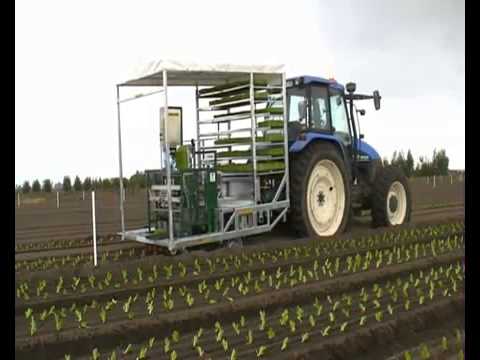
Field robot event
In 2016 there was a robot event in Hassfurt, Germany. One of the games they played there was a seeding game on the field. The robots have to operate on an area of 10 x 1 meters. The robot should take wheat seeds from a station and has to sow them on the area. There were no specific rules how the machines should complete the task. The robots had to distributes the seeds as even as possible and cover them with soil.
Other kinds of mini robot seeders:
Harvesting
There already are a few robots designed for the harvesting of crops. Due to the difference in the way certain crops should be picked, robots that harvest crops are often designed for one specific crop, such as bell pepper, cucumber or any other crop.
Sweeper[8]
The Wageningen University and Research center developed a robot for picking bell peppers in collaboration with a group of bell pepper growers. The robot is displayed below.
The robot picks the crops using a mechanical arm (The manipulator) and then places the crops into a container. To locate the peppers it uses multiple cameras to build a 3D picture, while trying to eliminate potential obstructions such as leaves. It has a special lighting rig to prevent bad light from being an issue. This robot was tested successfully in 2014, but was limited to slower speeds at that time due to fear that higher speeds may damage the crops.
MIT Robot Gardener
MIT developed its own gardening robot in 2009. The robot has a mechanical arm for picking the crops and a watering pump to water them. A difference with the usual approach here is that the robot does not contain any sensors to analyze the plants, the sensors are placed on the plants themselves. Using sensors that can detect soil humidity and other techniques borrowed from botanical science, the sensors broadcast the need per plant, giving this technique a high precision in picking and watering the plants.
Agrobot SW6010
The Agrobot SW6010 is a commercial berry picking robot. It features a rather large truck-like design, but is fully capable of autonomous harvesting of berries such as strawberries. To pick crops it utilizes a set of precision arms, with five arms on each side. Using the multiple arms, the robot can reach multiple plants and pick crops more efficiently. There is space for two passengers to check and sort berries that the machine collects. To identify the berries, the system uses the companies patented AGvision system, which supposedly determines the ripeness of the fruit by analyzing the color and form.
Cucumber harvester
Another project of the Wageningen University and Research center is a robot for cucumber harvesting, which utilized a double camera system and a mechanical manipulator arm to detect and harvest ripe cucumbers. They built and tested a prototype in 2001 and were able to detect 95% of the ripe cucumbers, and successfully picked 75% of those. The vision techniques developed by this robot can be found in multiple modern harvesting robots.
Flyer[9]
Berry Nice
This machine is a berry picking machine developed by the Japanese Shibuya corporation. It features robots that move on rails in contrast to most autonomous robots which use wheels. Using rails increases stability and speed, but makes adapting the system more difficult as the robot can only move to where the rails are. It also uses 3D stereo cameras to determine ripeness.
CROPS solution[10]
The CROPS solution is a modular adaptable robot to harvest ripe fruits, the project is sponsored by the European Union. The goal of the project is to develop a robot that can not only harvest one, but multiple types of crops easily. It uses FinRay fingers, which are adaptable grippers to hold a fruit, and a knife to cut the fruit off the plant. To detect ripeness, cameras and color and humidity sensors are used.
Fertilization
There are some different aspects in the fertilization process that are currently improved by the use of robots. Four of the main aspects are soil Electrical Conductivity mapping systems, GIS services, precision sampling and precision fertilization. Those four aspects will be discussed below.
soil Electrical Conductivity mapping systems
Soil Electrical Conductivity (EC) is a measurement that correlates to soil properties affecting crop productivity including soil texture, cation exchange capacity, drainage conditions, organic matter level, salinity (salt level) and subsoil characteristics. This information is used to make a fertilization plan. Soil EC is one of the simplest and least expensive ways of soil mapping for precision fertilization. Some examples of soil EC mapping systems are the EM38-MK2 sensor (left) and the Dualem 21s sensor (right).
Below, the result of a Soil EC measurement is given, this map is made by dragging the sensor across the field. The sensor measures how good the different patches of soil conduct electricity and the needed data can then be determined from this information.
GIS services
GIS is short for Geological Information System. GIS services use satellites to analyze all sorts of geological information. With the aid of GIS, maps of fields or farms are created with different layers (yield map, EC map, soil sampling, remote sensing, etc.), allowing the precise application of fertilizer (and other inputs) according to the variability of the field. Some examples of GIS services are Google Earth and esri.
Precision sampling=
Precision sampling is soil sampling with the use of global positioning system (GPS), which allows to precisely locate position in the field. First the field is mapped, after which a grid is placed over the field, dividing the field in smaller sections. In those grids sample sections are chosen, more sample sections means more accurate sampling, but also higher costs. GPS is then used to accurately take the samples, the accuracy of the GPS can be increased by using a correction signals. The accuracy can range from 500-1500cm to 1-2cm. Finally the soil is analyzed in a lab and the outcomes are displayed on a map.
Above is an example of a sampling grid. With this particular way of sampling the distribution of the sampling sections gives the most accurate outcome. It is called a diamond sampling pattern, since the sampling sections are in a diamond shape, as can be seen above.
Precision fertilization
There are a lot of machines for precise row fertilization. These machines inject the fertilizer into the ground in very precise quantities so that every spot gets the exact amount of fertilizer it needs. An example on the market is for instance the “precisiebemester”, this machine promises a simple and cheap way for precision fertilization. The amount of fertilizer given is regulated by the use of different gear combinations, for every situation a combination can be calculated. There are also some devices[11] for regulation available.
Another example is the machine of ‘Schoonen precisie bemesting’. For this machine special injection wheels are developed, that make tiny holes in which a little bit of fertilizer is injected. A big benefit of this technique is that the ground gets aerated as well. This also leads to an improved root system[12] for the plants.
Irrigation
Irrigation is a big part of agriculture, without enough water the plants cannot grow and the harvest is lost. It is easy to spray water everywhere, but if we know exactly where the water needs to be and how much, we can save a lot of water that is otherwise lost in the soil and doesn't go into the plants.
Drip Irrigation
When it comes to row crops, it is possible to install a system that is called drip irrigation. As the name already implies with such a system you can control how much water every row of plants get. Besides controlling the amount of water, it is also a more efficient way of watering plants because you only use water where it is needed, not on places where there are no plants. These drip strips can be applied at the surface of a row of plants or buried under ground down to about 0.45m[13]., depending on what is best for the crops it is used on. There are many different drip strips each with different properties and suitable for different crops and environments. They vary in diameter, wall thickness, emitter spacings and emitter flow rates[13]
Soil Moisture Monitoring
There currently exist equipment that can be used to measure the moisture levels of the soil. This is especially useful in combination with watering systems that can moisturize different parts of the field with different amounts of water. This equipment enable the farmer to exactly see how much water there still is and be able to determine if the crops need water or if they can wait for the next rainfall[15]. This has the advantage that the crops don’t get too much water if there is rain coming and also not too little if the time of the year is dryer than normal.
Automated Bay Outlets
If there is a source of water nearby a big section of land it can be an option to use bay outlets. These can control the flow of water and in turn be used to decide how much water a section of land needs to get. With automated bay outlets this can happen automatically, saving the farmer time[22]. Not only can it save time, it can also reduce the water usage with about 5% to 9%, depending on the soil type[15] . Because these systems use telemetry, they can also be used to share their data with a central system and/or receive data from a central system. This way working as a group instead of separate entities.
Center Pivot Irrigation
The idea behind center pivot irrigation is that there is a large machine that rotates around a center point (the pivot point) and sprinkles water on top of the crops it rotates above. The advantage of a center pivot irrigation system over classical irrigation systems is that it uses less water to moisturize the same amount of crops[18]. It also consumes less electricity than ordinary systems when water needs to be pumped up to the farm.
Pest control
Applying pesticide to the crops is an integral part to agriculture. It is a subject with a lot of public attention, mainly concerning drift. This ‘drift’ is when some of the pesticide gets carried by the wind, or the ground to a lesser extent, possibly spreading it to nearby houses. Pesticide is harmful to humans, thus it is reasonable for the public to be concerned. Another group of people that has high stakes in this subject are the workers that apply the pesticide. It can be dangerous to them because they are in direct contact with the pesticide. Lastly it obviously impacts the costs of agriculture as well. The more pesticide is needed, the more it will cost. A possible way of reducing all of the above problems is the spray more precisely by using robots. Preferably even on a plant specific level. There are currently robots being developed to handle pesticide spraying.
Pesticide Spraying Robot
An example is a robot created by an Australian team. This robot is meant for indoor usage only, but it does show a proof of concept that robots can eventually take this dangerous job on them and be more efficient with the pesticide. The latter being useful for all of the USE aspects.
Steps for Pest Control
Pesticide use relies on 2 aspects in order to make it automatic. We already have the above information about the spraying part, but that only gets us half way. That way we can remove the dangerous task of spraying from the workers, but it doesn’t do any of the other promised benefits. For these to work we need detection of insects, again preferably on plant level, so we can spray more precisely.
Pest Detection Technologies
To get this working there are multiple technologies in the works. There are 3 main options at the moment. These being: computer vision, (near) infrared and scanning a sample size of plants using destructive methods. This last one not really being applicable to the situation, but is more aimed towards testing the harvested crops before selling them. The first 2 are more useful to growing plants. Computer vision more up close on a plant-by-plant basis while (near) infrared could be used with a drone on a slightly bigger scale (but possibly plant-by-plant if the resolution is high enough and you don’t fly the drone too high)
Visiting van den Borne
We visited one of the most advanced precision farms in the Netherlands, where a lot of new techniques for precision agriculture are being used. The name of the farm is van den Borne potatoes. The biggest difference on their farm is that almost everything they do with the potatoes is done by precise machines. They are able to work with a precision of 6x6 meters.
We had a conversation with Jacob in which we talked about the pros and cons of precision farming and the usage of new technologies.
He explained to us that by using new technologies you will get more work, but it is worth it because of the higher yield gained. The investment in technologies costs a lot of money. But because of the precise measurement and management of the plant, you are able to reduce the overlap, meaning that there are less resources used. This saves a lot of money if you are a big farmer. The biggest problems he struggles with are the legal restrictions. There are many rules for flying with drones which makes it hard to work with this technology.
The cameras they are using are able to collect a lot of data. One of the cameras measures 5 different spectra, the standard RGB and the extra close-infrared and normal infrared. The pictures made with this camera are stitched together, so one big picture is gained. This picture is then analyzed. With the pictures of another drone with a normal camera, they are also able to make a 3d model of the farmland.
Jacob explained that the precision farming is mostly used with corn, wheat and grass. Van den Borne grows potatoes, because potatoes have a high efficiency. He also explained to us that if the bottom of your farming land exists of sand, you have to add liquid manure. When working with the precision agriculture concepts on sand the results are much better.
All machines that are required for executing the process of growing potatoes are designed for operating with GPS. Everything that happens on the land of van den Borne will be actuated by a computer.
The only part that is difficult with the technology is that it is simple to measure all kinds of things, but it is difficult to process the 'raw data' to data you can work with. It will always stay hard to exactly tell, out of a picture, where you should change something for optimizing the grow process.
The current project he is working with right now, is that of a building team that tries to build a new drone. And because of the legal restrictions he is observing the possibilities for using drones that fly with a fixed power cable.
Models
To create a solid mathematical model a list of all the important variables need to be made. Then the relations between those variables can be describes to create the model.
The first model which is made is the economical model for The Netherlands. A list of relevant variables can be found underneath. This list is not complete yet!
| Inputs | Process constants | Process variables | Outputs | |||||||||
|---|---|---|---|---|---|---|---|---|---|---|---|---|
| Name | Abbreviation | Description | Name | Abbreviation | Description | Name | Abbreviation | Description | Name | Abbreviation | Description | |
| 1 | 2 | 3 | 4 | 5 | 6 | 7 | 8 | 9 | 10 | 11 | 12 | |
| Climate | Yield | Time flying | Money | |||||||||
| Soil | Overlap | Time image processing | ||||||||||
| Crop | Investment drone | |||||||||||
| Size fields | Investment software | |||||||||||
| Spare time farmer | Type camera | |||||||||||
| Purchasing cost water | Quality camera | |||||||||||
| Purchasing cost pesticides | Earnings expert | |||||||||||
| Purchasing cost fertilizer | ||||||||||||
| Purchasing cost weed killer | ||||||||||||
| Purchasing cost seeds | ||||||||||||
Below, the first draft of the Visio model can be seen, in this graph the variables are displayed by a rectangle and the relations with diamonds. Towards the costs the relations are either determines(+) of determines (-), the determines(+) relations are the gains and the determines(-) relations are the costs. Furthermore, in the bottom left corner the variables overlap and climate can be seen, those won't be taken into account in the model due to the reasons stated beside them.
Consultancies / outsourcing companies
To be able to generate an advise for farmers whether to invest in drone technology or not, it is important to know what it would cost them to outsource the task. And what general consultancy costs are.
The following outsourcing companies were found:
Loonbedrijf Thijssen Nieuwehorne
This company uses soil sensors and an EBee drone to preform precision agriculture. They claim to that their services can reduce use of water, fertilizer and pesticides by 70%. The pixel size of the EBee drone is 10 cm, which creates detailed crop information maps.
De Samenwerking BV Elsloo
This company uses a lot of GPS to decrease overlap and increase efficiency, but they don't use drone image processing. They mainly equip their machines with GPS to be able to adjust the amount of different inputs depending on the location. However it might be very useful to contact to company to ask what their opinion is about the use of drones.
PrecisionHawk
PrecisionHawk is a company that offers drone solutions for all kinds of applications. One of these applications is agriculture. The company offers total packages which consist of the drone, service, apps and software. The user has to buy a license for the software annually. The cheapest and simplest packages which is offered is the 'Crop Scouting Package', which start from +- 1200 US dollar. The most complete package is the 'Lancaster Standard Kit'. This package start from 13000 US dollar.
The software offers a wide variety of diagnostic tools to evaluate the soil and the crops.
Company Thijssen, based in Nieuwehorne, is the only drone outsourcing company found in The Netherlands. Contact with this company will ensure that some key parameters for the model are obtained.
Crops
Potato
Production
In 2014 the countries with the highest potato production were China and Russia (69 and 33 million tonnes relatively).[19]. The Netherlands ranks 9th, however considering the population of said countries this is quite impressive. With the highest production per head being in Europe. The list is as follows according to “Food and Agriculture Organization of the United Nations”[20]:
| Country | Production (tonnes) |
|---|---|
| China | 39.0 |
| Russia | 33.5 |
| India | 28.9 |
| USA | 20.4 |
| Ukraine | 18.8 |
| Poland | 15.2 |
| Germany | 11.4 |
| Belarus | 8.0 |
| Netherlands | 7.1 |
| France | 6.6 |
The Plant
The potato plant reaches a length of about 60 cm [21] and can produce up to 300 seeds. There are over 4000 varieties of potatoes [22], but the most cultivated species is Solanum tuberosum. Each potato holds about 322 kJ per 100g[23]
Growth Process
Growth takes place in five stages:
| 1. Sprout and root growth |
| 2. Photosynthesis |
| 3. Stolons grow (runners, new plants can emerge from these) (stops above 27C) |
| 4. Tuber bulking (at this moment these factors are critical: optimal soil moisture and temperature, soil nutrient availability and balance, and resistance to pest attacks) |
| 5. Maturation (sugars convert to starches) |
Potatoes are very sensitive to frost and can grow on any type of soil except saline and alkaline and preferably loose (pH 5.2 to 6.4). The average world farm yield for potatoes was 17.4 tonnes per hectare, in 2010. (America 44.3 tonnes per hectare and some new zealand farmers 60 to 80 tonnes per hectare) [24]
Maize
Production
The production of maize is the highest in the USA and China (361 and 216 million tonnes respectively)[19] with the land efficiency being around 5.6 tonnes/ha in 2014[19]. The list is as follows according to “Food and Agriculture Organization of the United Nations”[19]:
| Country | Production (tonnes) |
|---|---|
| USA | 361.1 |
| China | 215.6 |
| Brazil | 79.9 |
| Argentina | 33.1 |
| Ukraine | 28.5 |
| India | 23.7 |
| Mexico | 23.3 |
| Indonesia | 19.0 |
| France | 18.3 |
| South Africa | 14.3 |
The Plant
Maize (meant for harvest) grows about 3m in height[25], however some natural varieties are able to grow to lengths of 12m[26].
Growth Process
In the milk stage pollination has taken place but starch hasn’t formed yet, this is when corn can be harvested to get sweet corn. Sufficient soil moisture is critical to the growth of corn. Further it is a very versatile crop when it comes to climate[27].
Wheat
Production
The production of wheat is the highest in the China and India (108 and 75 million tonnes respectively)[19] with the land efficiency being around 3.3 ton/ha in 2014 and a maximum of 10 ton/ha.[20] The list is as follows according to “Food and Agriculture Organization of the United Nations”[19]:
| Country | Production (tonnes) |
|---|---|
| China | 107.9 |
| India | 75.1 |
| USA | 59.2 |
| Russia | 44.1 |
| France | 36.1 |
| Canada | 25.4 |
| Germany | 22.0 |
| Australia | 21.0 |
| Pakistan | 20.6 |
| Turkey | 19.6 |
Nutrients
| Nutrient component: | Maize / Corn | Wheat | Potato | RDA |
|---|---|---|---|---|
| Water (g) | 10 | 13 | 79 | 3000 |
| Energy (kJ) | 1528 | 1369 | 322 | 2000–2500 |
| Protein (g) | 9.4 | 12.6 | 2.0 | 50 |
| Fat (g) | 4.74 | 1.54 | 0.09 | |
| Carbohydrates (g) | 74 | 71 | 17 | 130 |
| Fiber (g) | 7.3 | 12.2 | 2.2 | 30 |
| Sugar (g) | 0.64 | 0.41 | 0.78 | |
| Calcium (mg) | 7 | 29 | 12 | 1000 |
| Iron (mg) | 2.71 | 3.19 | 0.78 | 8 |
| Magnesium (mg) | 127 | 126 | 23 | 400 |
| Phosphorus (mg) | 210 | 288 | 57 | 700 |
| Potassium (mg) | 287 | 363 | 421 | 4700 |
| Sodium (mg) | 35 | 2 | 6 | 1500 |
| Zinc (mg) | 2.21 | 2.65 | 0.29 | 11 |
| Vitamin C (mg) | 0 | 0 | 19.7 | 90 |
| Vitamin B6 (mg) | 0.62 | 0.3 | 0.30 | 1.3 |
| Vitamin A (IU) | 214 | 9 | 2 | 5000 |
| Vitamin E (mg) | 0.49 | 1.01 | 0.01 | 15 |
| Vitamin K1 (μg) | 0.3 | 1.9 | 1.9 | 120 |
Logbook
| Week | 1 | 2 | 3 | 4 | 5 | 6 | 7 | 8 |
|---|---|---|---|---|---|---|---|---|
| Guus van Dongen | Visited van den Borne. Prepared an interview and processed the results. Made a presentation, planning and gannt chart. | Had contact with Straver and Jan Staal but they had no time last week. Prepared Interviews. Collecting valuable information from 'Boerderij' and CBR. | ||||||
| Johan Somers | Brainstormed about the subject to research and did a general information search on the topic of robotics in agriculture. | Also went to Van den Borne, and prepared and gave the presentation. Also did a state of the art research to weeding robots. | Update the wiki and add parts of the model variables and the project description (2.5 hours), had a useful brainstorm with the group to make a start with the model, searched for consultancies and drone outsourcing companies. | |||||
| Teun de Groot | Brainstorming and finding useful sources about our topic, robotics in agriculture. | Went to Van den Borne for an interview. Did a state of the art research about use of robots in the fertilization process. Correcting wiki in grammar and syntax. | Made a first draft for the Visio chart for the economical model. | |||||
| Jur Bartels | Brainstorming about the topic, finding resources and making a start with the wiki | Did state of the art research for robots in harvesting, updated wiki | Researched previous work done in modelling impact of robotics in agriculture, created logbook and task list in the wiki | |||||
| Laurence Keijzer | Brainstorming about robotics in agriculture + research. | Went to Van den Borne for the interview + state of the art research about use of robots in irrigation. | ||||||
| Bastiaan Wuisman | Research about our topic and thinking about a topic. | Visited Van den Borne for an interview about his farm. Did a state of the art research about use of robots in pest control. |
References
- ↑ https://ourworldindata.org/world-population-growth/
- ↑ http://www1.wfp.org/zero-hunger
- ↑ http://eprints.lse.ac.uk/61155/1/__lse.ac.uk_storage_LIBRARY_Secondary_libfile_shared_repository_Content_Centre_for_Economic_Performance_Discussion_papers_dp1335.pdf
- ↑ https://www.researchgate.net/profile/Spyros_Fountas/publication/225527407_Agricultural_robots-System_analysis_and_economic_feasibility/links/00b49528e6ebce9eda000000/Agricultural-robots-System-analysis-and-economic-feasibility.pdf
- ↑ https://pdfs.semanticscholar.org/851d/0d9f6bc13986012beea5d5e88b543699d3f3.pdf
- ↑ http://www.insidepolitics.org/brookingsreports/robots.pdf
- ↑ http://www.dairyherd.com/news/german-company-demonstrates-automated-weeding-machine
- ↑ http://www.crops-robots.eu/index.php?option=com_content&view=article&id=22&Itemid=22
- ↑ http://www.wur.nl/upload_mm/5/5/7/c221711e-98da-4865-805a-8fc8531aa624_flyer_cucumber%20harvesting_robot_uk.pdf
- ↑ https://www.festo.com/cms/en_corp/14014.htm
- ↑ http://www.precisiebemester.nl/precisiebemester/index.html
- ↑ http://www.precisiebemesting.nl/techniek.html
- ↑ 13.0 13.1 https://www.ksre.k-state.edu/sdi/abstracts/drip-irrigation-of-row-crops.pdf
- ↑ https://en.wikipedia.org/wiki/Drip_irrigation
- ↑ 15.0 15.1 http://vro.agriculture.vic.gov.au/dpi/vro/vrosite.nsf/pages/lwm_state_art_irrigation_docs/$FILE/Stateoftheart_edition1_web_tagged_final.pdf
- ↑ http://vro.agriculture.vic.gov.au/dpi/vro/vrosite.nsf/pages/lwm_state_art_irrigation_ed1
- ↑ 17.0 17.1 http://vro.agriculture.vic.gov.au/dpi/vro/vrosite.nsf/pages/lwm_state_art_irrigation_ed2
- ↑ http://vro.agriculture.vic.gov.au/dpi/vro/vrosite.nsf/pages/lwm_state_art_irrigation_docs/$FILE/Stateoftheart_edition2_web_tagged_final.pdf
- ↑ 19.0 19.1 19.2 19.3 19.4 19.5 19.6 19.7 19.8 http://www.fao.org/faostat/en/#data/QC/visualize
- ↑ 20.0 20.1 http://www.fao.org/home/en/
- ↑ https://books.google.nl/books?id=QDrqL2J-AiYC&pg=PA209&dq=potato+plants+60+cm&redir_esc=y&hl=nl#v=onepage&q&f=false
- ↑ http://news.nationalgeographic.com/news/2002/06/0610_020610_potato.html
- ↑ https://ndb.nal.usda.gov/ndb/search/list
- ↑ 24.0 24.1 http://www.fao.org/potato-2008/en/potato/cultivation.html
- ↑ https://books.google.nl/books/about/Races_of_Maize_in_Mexico.html?id=tXxQAAAAMAAJ&redir_esc=y
- ↑ http://www.agron.missouri.edu/mnl/86/MNL86.pdf
- ↑ Fernandez-Armesto, Felipe (2011). "The World: A History", p. 470
Sources
1.Company that makes ground scans and 3D scans with drones: https://3dr.com/ 2.Drones made for agriculture: https://www.sensefly.com/applications/agriculture.html 3. Drones that also map the ground: http://www.precisionhawk.com/ 4. Examples of agriculture robots: https://www.intorobotics.com/35-robots-in-agriculture/ 5. Some facts and companies analyzed: https://www.therobotreport.com/news/ag-in-transition-from-precision-ag-to-full-autonomy 6. Benefits analyzed: https://www.geospatialworld.net/article/drones-and-robots-future-agriculture/ 7. Professors etc. giving their views: http://fruitworldmedia.com/index.php/featured/robots-huge-potential-robotics-agriculture-industry/ 8. Japanse company that founded a fully autonomous indoor farm: http://spread.co.jp/en/sustainable-farming/ 9. Project of the EU for percision lifestock farming: http://www.eu-plf.eu/index.php/publications/ 10. eLeaf technology: http://www.eleaf.com/products-showcase-fruitlook#technology-pimapping 11. Automated precision weeding: http://www.bluerivert.com/ 12. Case study of drones in argiculture https://blog.dronedeploy.com/case-study-ce39c9f44e48#.tsnfhikpp 13. Mechanical weeding robot http://link.springer.com/article/10.1023%2FA%3A1015674004201?LI=true 14. Seeding and fertilazation robot goo.gl/s2ehLC 15. Machine-to-machine communication goo.gl/UVJDFS 16. Framework for argicultural systems goo.gl/RGzsuo 17. Farmer in the Netherlands which uses the drone: http://www.loonbedrijfthijssen.nl/contact/ 18. An other farmer in that uses drones: http://www.vandenborneaardappelen.com/ 19. Bosch Weeding Robot: https://www.deepfield-robotics.com/en/Weeding.html 20. Drip Irrigation Of Row Crops: What Is The State Of The art? https://www.ksre.k-state.edu/sdi/abstracts/drip-irrigation-of-row-crops.pdf 21. State of the art - on irrigation farms. Edition 1 http://vro.agriculture.vic.gov.au/dpi/vro/vrosite.nsf/pages/lwm_state_art_irrigation_docs/$FILE/Stateoftheart_edition1_web_tagged_final.pdf 22. State of the art - on irrigation farms. Edition 2 http://vro.agriculture.vic.gov.au/dpi/vro/vrosite.nsf/pages/lwm_state_art_irrigation_docs/$FILE/Stateoftheart_edition2_web_tagged_final.pdf 23. Pesticide spraying robot: http://www.araa.asn.au/acra/acra2005/papers/sammons.pdf
